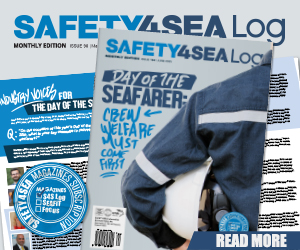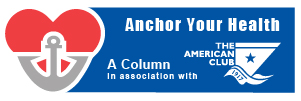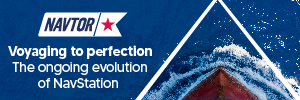BSU has issued an investigation report into the grounding of an ultra-large container ship which occurred during a turning maneuver near a fairway while navigating towards a German port.
The incident
On 02/02/2022, the ultra-large container ship (ULCS) MUMBAI MAERSK was en route from Rotterdam in the Netherlands to Bremerhaven in Germany. The ship had decided to use the further seaward deep-water route for the voyage. In the course of a turning manoeuvre before entering the narrow section of the “Neue Weser” fairway, the ship ran aground on a dumping ground for dredged spoils next to the fairway.
While approaching the narrow fairway section, the MUMBAI MAERSK was advised by radio that its berth would remain occupied for longer than planned, but would soon become vacant. Due to its draught of 12.80 m, the ship was tide-dependent. The vessel initially proceeded to cross the pilotage area border. Due to the continued delay in the departure of the outbound vessels, however, the MUMBAI MAERSK turned back and sailed in the opposite direction before entering the section of the fairway where neither turning nor the safe passing of two large ships is easily possible.
Less than 30 minutes later, the MUMBAI MAERSK was informed that it could now sail for Bremerhaven, after all. Accordingly, another turn was immediately executed to return to the original course. The planned manoeuvre failed for various reasons, and the MUMBAI MAERSK ran aground directly south of the fairway on a dumping ground for dredged spoils.
The German Central Command for Maritime Emergencies (CCME) was notified and assumed overall command of the operation just over an hour later. After extensive planning by a salvage company and one failed salvage attempt, it was reported that the ship had been refloated at 0114 on 04/02/2022.
The diving inspection of the underwater hull for class maintenance, as well as all class surveys, were carried out at the next port of call (Århus in Denmark). To this end, an interim permit to continue the voyage was issued in Bremerhaven after the ship had entered the port under its own steam. The inspection revealed that, apart from paint abrasions, the ship had not sustained any damage during the accident.
Conclusions
After investigating and evaluating all available information, the BSU has arrived at various conclusions. Building upon this, specific safety recommendations are then provided to avoid similar accidents in the future.
Voyage Appraisal and Planning – before the voyage
The accident highlighted the importance of ensuring that the passage plan includes information on the settings of contour lines for different voyage segments and alarm management. At the same time, the relevant procedural instructions for voyage planning have to be internally consistent. Unsuitable safety settings on the ECDIS can, on the one hand, render warnings and alarms meaningless or so intrusive that they are ignored or disabled. On the other hand, an impractical display of objects and isolated hazards within the safety contour – particularly when crossing it is unavoidable – can make it more difficult to identify shallow areas, for example.
The delayed recognition of the discharge area and the associated risk of grounding resulted from the difficulty in distinguishing safe from unsafe waters at a glance. No-go areas must therefore be consistently marked with appropriate user symbols to ensure they are reliably identified, even in time-critical situations.
Voyage Execution and Monitoring – during the voyage
Using the integrated navigation system
- The settings that had been made on board the MUMBAI MAERSK were unsuitable for effective voyage monitoring and contributed to the impairment of situational awareness. The alarm settings must be configured according to the respective voyage segment.
- The automated alarms and warnings via the COG-based look-ahead sector did not constitute an appropriate addition to the manual monitoring of the surrounding sea area, especially during the turning manoeuvres.
- The BSU is of the opinion that the MFDs used by the navigator should not allow prolonged use of the ECDIS in browse/planning mode while underway for viewing areas away from the vessel’s own position, especially if the cursor is not moved. Onboard MUMBAI MAERSK, this contributed to a reduction in situational awareness, as the vessel’s progress was not continuously monitored on the navigator’s ECDIS.
Chosen manoeuvres
- Prior manoeuvre planning and foresighted positioning of the ship in the fairway would have enabled both turning manoeuvres to be executed safely. Sufficient manoeuvring space was, in fact, available between the buoy pairs in the approach to the dredged Neue Weser.
- The widening of the turning circle during the return turn ultimately led to the vessel’s grounding. A turn between buoys 3a and 4a would have been safely possible if the manoeuvre had started further north or west. However, even at the chosen starting position, grounding would not necessarily have occurred without the intervention, though contact with buoy 3a could not have been ruled out.
- The BSU believes that the evasive manoeuvre that was ultimately chosen – passing between the buoy and the discharge area – would always have failed. This is especially true given the initial conditions, where the vessel was already in a turning motion in close proximity to the buoys, as well as the prevailing current and wind conditions.
- However, in the opinion of the BSU, the root cause of the accident was not merely the decision to attempt this manoeuvre. The real issue was that an experienced bridge team found itself in a situation where such a decision had to be made at all.
- There was no discussion about aborting the manoeuvre due to the uncertain time frame. In situations in which safe passage appears at risk, it should be considered to forgo the entry and wait for the next tidal window.
Bridge Resource Management (BRM)
- The accident demonstrated the value of discussing navigation-related matters at an early stage, such as during the MPX. On MUMBAI MAERSK, there were no manoeuvre plans for potential alternative or emergency manoeuvres due to a lack of preparation. As a result, the decisions to initiate opposite-course manoeuvres were made ad hoc on two occasions.
- On the day of the accident, the high volume of communication made it impossible for the pilot alone to ensure safe navigational advice. He did not have sufficient resources to diligently perform all his duties as a member of both the shore-based and the bridge team.
- Internal communication (content, topics), language barriers and a lack of technical resources (no dedicated MFD) meant that the third officer could not perform his duties as co-navigator and “safety barrier” effectively. Effective use of bridge resources (both technical and human) and focused team communication, however, are essential for maintaining situational awareness. Information processing on the bridge, including the (necessary) additional radio communication heard over the radio, was overloaded. In the case of a significantly increased volume of communication and/or unforeseen changes to the passage plan, it must be ensured that safe navigation and voyage monitoring remain the top priority for the bridge team.
Approach planning
- Changes in ship sequence and approach planning could not be shared in real time with all involved parties. The absence of a central information system caused delays in information transmission to all stakeholders and led to an increased volume of communication.
- As a central communication hub, the VTS centre was not always able to ensure timely sharing of information, particularly in situations involving multiple actors and deviations from the original arrival plan.
Pilot allocation
- The ship only had one pilot that evening. As a rule, this practice does not pose a problem in this pilotage area. However, in the opinion of the BSU, it would have been extremely beneficial on the evening in question if the pilot on board had been accompanied by a colleague solely responsible for communication, since this really did take up about half of his time (see above).
Communication
Maintaining radio discipline between the involved pilots by correctly identifying radio stations and communicating using only the equipment on board would have better enabled the bridge team to develop complete situational awareness. Maintaining radio discipline between the involved pilots, correctly identifying radio stations, and using only the communication methods designated on board would have better enabled the bridge team to develop a complete situational awareness. Otherwise, other vessels without pilots (e.g., pilot exemption certificate holders, small craft) and bridge team members miss crucial information or cannot interpret it properly.
Actions taken
Discussions are currently ongoing for Bremen, Bremerhaven, and Wilhelmshaven regarding the development of a data-driven, centralised arrival planning system for the Rivers Weser and Jade.
In response to this accident, Maersk has revised the basis of its internal ECDIS training programmes. The trainings now explicitly incorporate lessons learned from cases such as the grounding of MUMBAI MAERSK to ensure cross-team knowledge sharing of the gained insights.
The Weser II / Jade Pilots’ Association regularly consults with the GDWS regarding potential changes to the requirements within the pilotage area. The topic of pilot allocation is also regularly discussed. Even after reviewing this accident, however, both parties see no reason to change the existing practice.
Safety recommendations
WSA Weser-Jade-Nordsee
The BSU makes the following recommendations to WSA Weser-Jade-Nordsee:
The existing, historically evolved system of arrival planning for the rivers Jade and Weser should be revised to ensure that information on changes to arrival schedules reaches, or can be viewed by, all relevant parties in real time, as far as this is possible. This could be achieved by establishing a digital, centralised information platform. Such a platform would not conflict with the responsibilities of the VTS centre or the current communication structure, but would rather serve as a complement to them.
Weser II / Jade Pilots’ Association
The BSU makes the following recommendations to the Weser II / Jade Pilots’ Association:
- As far as this is possible, mobile phones should not be used for making calls or for any other purpose during pilotage.
- In the long term, the focus should instead be on supporting the development of the alternative centralised information platform described in 7.1 and integrating it into the PPU, for example.
- In cases where adhering to a time window poses a risk to safe passage, entry should be avoided, and the next tidal window should be awaited.
- Basic radio discipline, correctly identifying radio stations, should be maintained at all times. When communicating by radio in the pilotage area, all parties should bear in mind that a lack of radio discipline can deprive certain traffic participants (e.g., pilot exemption certificate holders, small craft) of crucial information or the ability to interpret it properly.
Federal Waterways and Shipping Administration (GDWS) and Weser II / Jade Pilots’ Association
The BSU recommends the following to the Federal Waterways and Shipping Administration (GDWS) and the Weser II / Jade Pilots’ Association:
The mandatory allocation of two sea pilots for large vessels in the Weser pilotage area should be reviewed. Many of the arguments put forward by the Federal Waterways and Shipping Agency (WSA) Elbe-Nordsee for implementing this measure on the Elbe (see Chapter 3.2.9.2) also apply to the Weser.
Mærsk Line A/S
The BSU makes the following recommendations to Mærsk Line A/S:
- Appropriate measures, such as training, must ensure that all nautical officers have a deep understanding of the functionality and principles of the ECDIS anti-grounding features.
- In the BRM courses for deck officers conducted or arranged by Mærsk Line A/S, special emphasis should be placed on always relaying information to:
− junior officers in the bridge team,
− members of the bridge team who do not speak the language of the pilotage area. - Similarly, special emphasis should be placed on a well-structured distribution of tasks within the bridge team.
- The procedural instructions for voyage planning should be revised, and the templates for the voyage passage plan should be updated.






























































